IC 1805
11/09/2016. I've aimed a little east of the photo on the previous page with the idea of extending a panorama in that direction. The eastern boundary of the image will be beyond the bright cluster NGC 1027. There's a lot of moon out there tonight, so I'm concentrating on H-a, but I've tossed in a little O-iii so I can work up some color. To do so, I shepherded two O-iii frames at the beginning of a long H-a run and will trust Maxim to work in another sometime later. Most of the work I've left the camera doing involves collecting 16 H-a frames. With that I'm calling it a day. And a night.
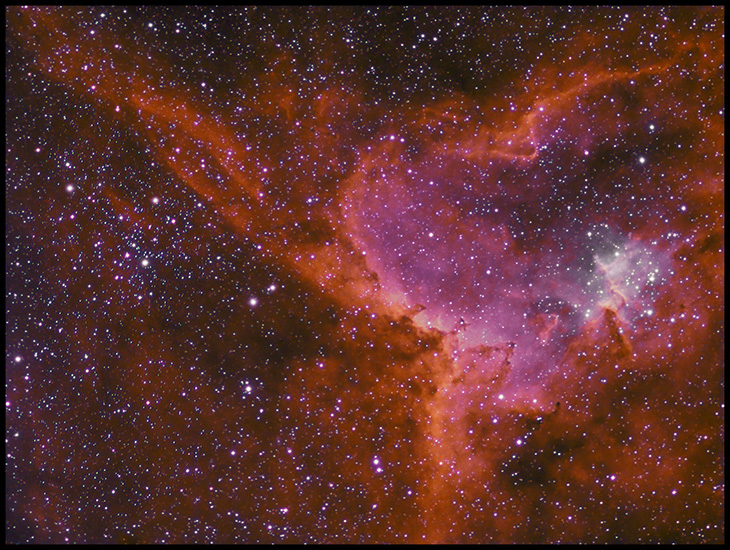
IC 1805 with NGC 1027 (left)
18x900s H-a + 3x900s Oiii, H-a as luminance (5h 15m)
TMB92SS @ F4.4, ST2000XM, Baader filters.
(Guide 9.1, uninverted, 0°.)
Click it if you're so inclined.
The orientation ring worked like a charm (Guide 9.1: 0°, uninverted).
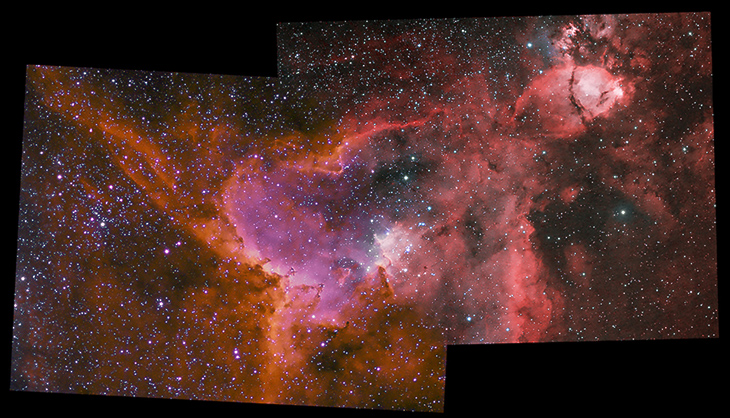
IC 1805 complex.
Two frame panorama.
Click to enlarge.
11/10/2016. Night before last, the woods were full of owls. Last night, the air was full of smoke. Wildfires in the foothills and mountains. Droughts are great for stargazing until someone dries up and bursts into flame. I started the night with a quick look at M27, spent an hour or so with the Bubble, and settled in for the night with the California Nebula, NGC 1499. There's too much Moon to do anything but H-a well, so that's what I did almost exclusively. That said, O-III and M27 will do wonderful things. NGC 1499 seems entirely without O-III, and lots of highlights around the Bubble need a determined effort with the CCD on some clearer, darker night. The best effort of the night is down below.
I've established where 0° and 180° are on the orientation ring. Now I need, once and for all, to find 90° and 270°. NGC 6940 will provide an excellent test case: a bright asterism falls on the guide chip at 270° but nothing much lands there at 90°. Also, check polar alignment: the high reject map from PixInsight's image integration routine shows field rotation around the guide star. [The next night: 270 is filter motor down, the most "natural" mounting position for the ST-series cameras. I used the RAPAS to realign the polar axis. It was out by several arc minutes.]
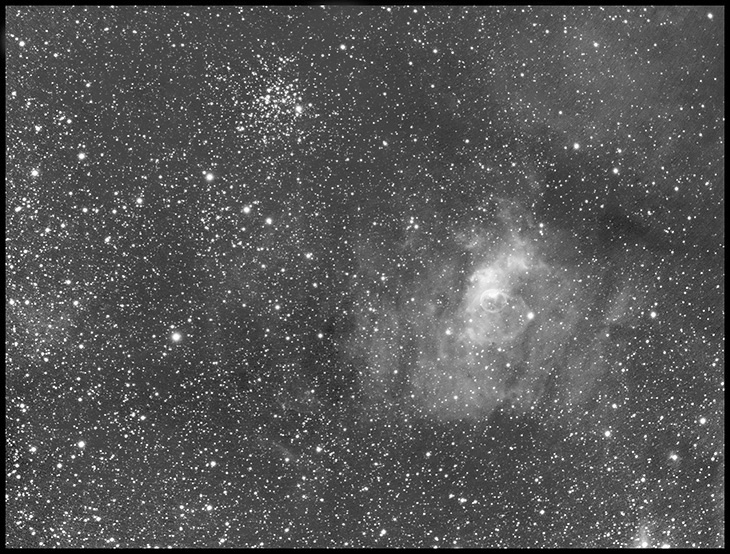
M52 and The Bubble Nebula
13x900s H-a (3h15m)
2016/11/11. One ring to rule them all. Part two. I wrapped a printed scale around the circumference of the orientation ring after verifying under the stars where 0-90-180-270 positions really are. The numbers correspond to the CCD rotation shown in Guide 9.1. Want a particular composition and known-good guidestars? Dial it in. Let's say this saves 20 minutes per subject per observing night and that I observe two targets each useful night. Suppose one out of ten nights is useful (North Carolina...). So that's 36 nights times two targets times 1/3 of an hour each comes to 24 hours saved per year. And not just any 24 hours, either. Really frustrating hours.

SBIG self-guiding CCD set to 5 degrees on the orientation scale.
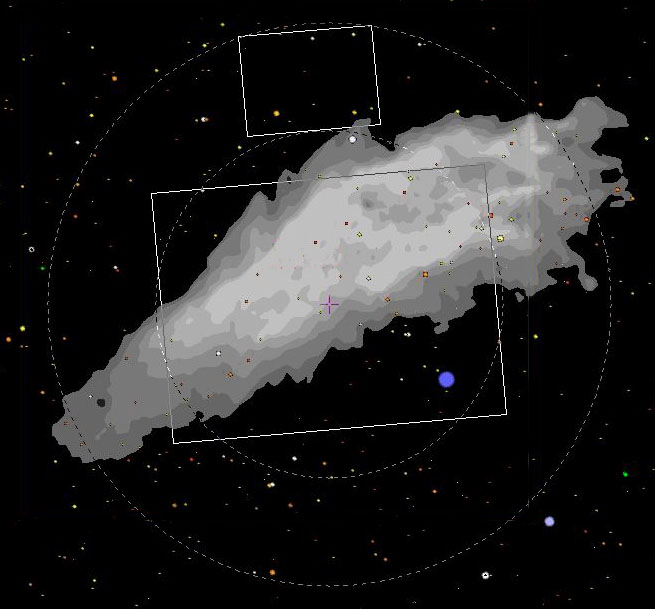
NGC 1499 in Guide 9.1, uninverted, north up, CCD overlay at 5 degrees
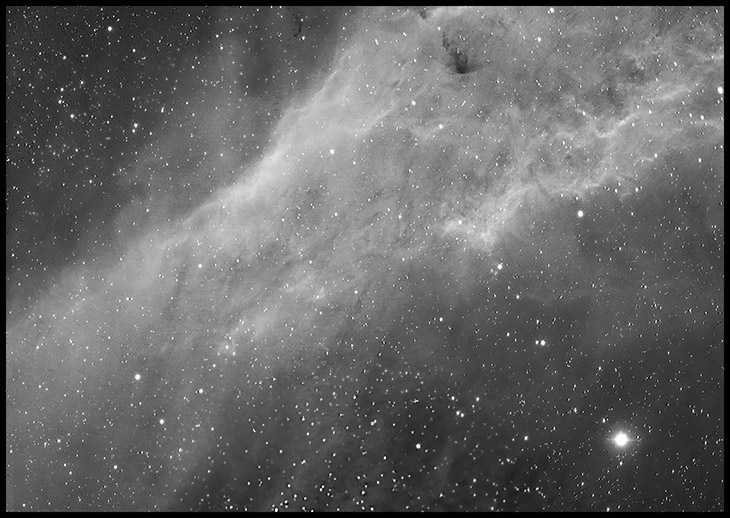
NGC 1499
16x900s H-a (4h00m)
(Waiting for color before sharing a big one.)
Here's the scale itself should it ever need to be reprinted. Would it be better with the numbers on the top side of the hashmarks? Yeah, probably. If it matters, take five minutes to move them, reprint it, trim it, coat the back with photo-mount adhesive, wrap it around the aluminum ring, tape it over for durability, trim the excess tape, and put the ring back on the 'scope. OK, maybe ten minutes.

My deep-sky photos are made with a variety of sensors and optics. Deepest images usually come from a SBIG ST2000XM CCD behind a 10-inch Astro-Tech Ritchey-Chretien carried on an Astro-Physics Mach1GTO. The CCD is equipped with a CFW-10 loaded with Baader wide- and narrow-band filters. Camera control and guiding are handled by Maxim DL 5.12. A Canon 6D and a modded 50D find themselves mounted behind an Orion 10" F4 Newtonian or a 92mm Thomas Back refractor or a tiny but mighty AT65EDQ refractor, sometimes with Backyard EOS in control and PHD Guide keeping things on target. Really widefield photos are often made using the 6D and various camera lenses and an iOptron Skytracker mount. PixInsight does most of the heavy lifting in post-processing — alignment, stacking, gradient removal, noise-reduction, transfer function modification, color calibration, and deconvolution. Photoshop along with Focus Magic and a handful of other plugins get their licks in, too, especially when polishing for the web.
:: top ::